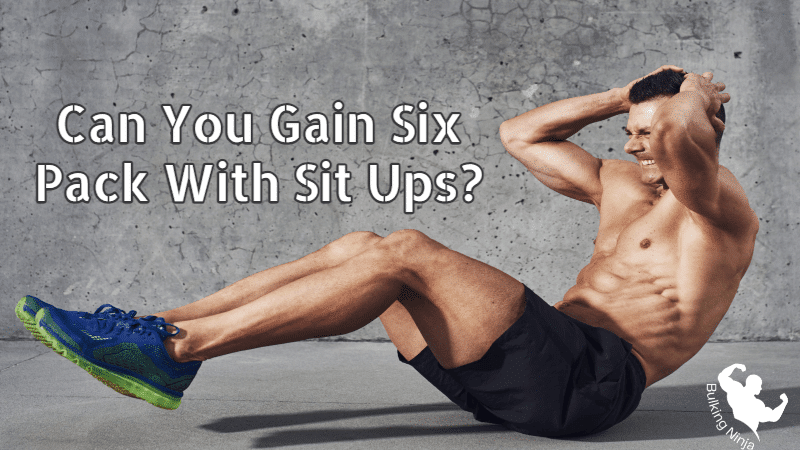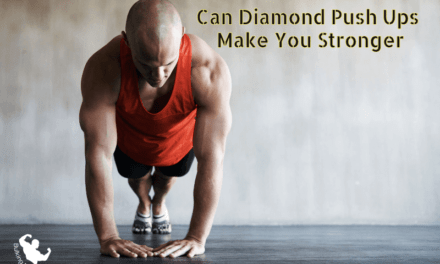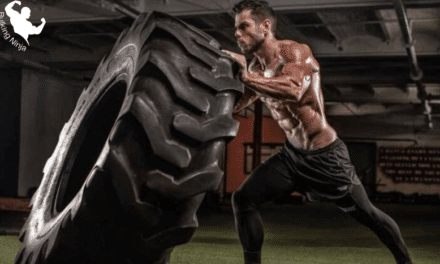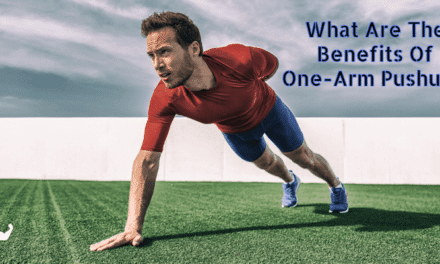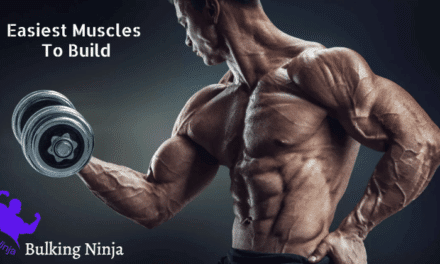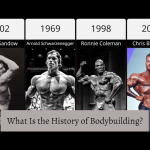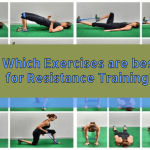In the pursuit of a chiseled, six-pack abdomen, sit-ups have long held a place of prominence in the realm of fitness. These seemingly simple abdominal exercises have been a go-to choice for many aiming to sculpt their midsection. But the question that often arises is: Can you really gain those coveted six-pack abs solely through sit-ups?
In this blog post, we’ll delve into the world of abdominal fitness, separating fact from fiction, and explore can you gain six pack with sit ups, furthermore the effectiveness of sit-ups in achieving a lean and defined core. Join us on a journey to uncover the truth about sit-ups and whether they can truly help you attain the six-pack you’ve been striving for.
Table of Contents
Can You Gain Six Pack With Sit Ups?

Gaining six-pack abs solely through sit-ups is a common misconception in the world of fitness. While sit-ups can be a valuable part of your core-strengthening routine, they alone are unlikely to give you that sought-after six-pack appearance. Achieving visible six-pack abs involves a combination of factors that go beyond sit-ups.
Nutrition plays a crucial role in revealing your abdominal muscles. To reduce body fat and showcase your abs, you need to maintain a healthy, balanced diet with a caloric deficit.
Incorporating cardio exercises, such as running, cycling, or HIIT, helps burn calories and reduce overall body fat, including the fat covering your abdominal muscles. Compound exercises like squats, deadlifts, and planks engage your core muscles more effectively than sit-ups, helping to build core strength and definition.
Relying solely on sit-ups can lead to muscle imbalances and potential back strain. It’s important to include a variety of core exercises to target different abdominal muscles. Consistent effort and patience are key. Visible six-pack abs may take time, and genetics also play a role in how your abdominal muscles appear.
Sit-ups are a helpful component of a comprehensive core-strengthening routine, but they should be combined with a balanced diet, cardiovascular exercise, and overall fitness regimen to achieve six-pack abs. Remember that spot reduction (losing fat from a specific area through targeted exercises) is not a realistic approach, so a holistic approach to fitness is essential.
How to do Sit Ups Workout?

Performing sit-ups with proper form is crucial to maximize their effectiveness and minimize the risk of injury. Here’s a step-by-step guide on how to do sit-up workouts:
Starting Position
Setup: Begin by finding a comfortable, flat surface to lie on, such as an exercise mat or a carpet. You may want to use a mat to cushion your back.
Body Position
Lie on your back with your knees bent and your feet flat on the floor, hip-width apart. Keep your feet flat throughout the exercise. You can also have a partner or an object, like a bench, hold your feet down if necessary for stability.
Hand Placement
Choose a hand position that you find comfortable. You can cross your arms over your chest, place your hands behind your head (without pulling on your neck), or extend your arms straight forward. The goal is to support your head and neck without straining them.
Performing the Sit-Up
Engage Your Core: Before you begin the movement, engage your core muscles by pulling your navel toward your spine. This will help protect your lower back and provide stability during the exercise.
Upward Phase: Exhale as you start to lift your upper body off the ground. Lead with your chest, not your head, and keep your chin slightly tucked. Avoid pulling on your neck with your hands.
Full Contraction: Continue to lift your upper body until your lower back comes off the ground. Ideally, you should sit all the way up until your elbows touch or come close to your thighs. This ensures a full contraction of your abdominal muscles.
Controlled Lowering: Inhale as you lower your upper body back down to the starting position. Control the descent, keeping your core engaged and maintaining a smooth, controlled motion.
Repeat: Perform the desired number of repetitions. Start with a number that challenges you but allows you to maintain proper form. Gradually increase the number of sit-ups as your core strength improves.
Tips
- Avoid using momentum to swing your body upward; instead, rely on your core muscles to lift you.
- Keep your feet firmly planted on the ground throughout the exercise to stabilize your body.
- Maintain a smooth, controlled motion throughout the sit-up, avoiding jerky or rapid movements.
- Focus on quality over quantity. It’s more important to perform sit-ups with good form than to do a large number of them.
Variations
To add variety to your sit-up workouts, you can try different sit-up variations, as mentioned in the previous responses, such as crunches, reverse crunches, bicycle crunches, and more.
Remember that consistency is key in building core strength and seeing results. Incorporate sit-ups and other core exercises into your regular fitness routine to achieve the best results. If you’re new to exercise or have any concerns, consider consulting with a fitness professional for guidance and personalized recommendations.
Does Sit ups Build Core Muscles?
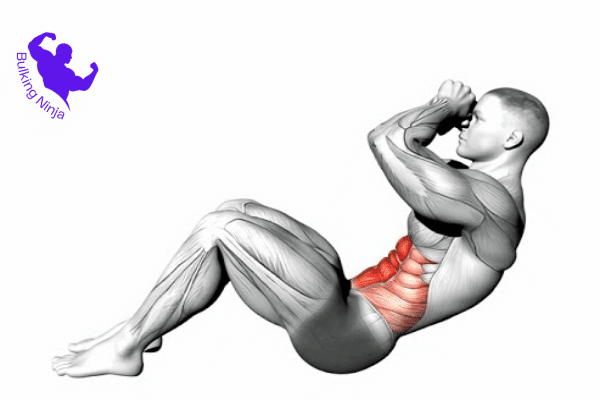
Sit-ups are effective at building core muscles, particularly the rectus abdominis, which is the front part of the abdominal muscles commonly referred to as the “six-pack.” Sit-ups involve flexing the spine and contracting the abdominal muscles to lift your upper body off the ground. This action targets and strengthens the rectus abdominis, helping to develop core strength and definition.
However, it’s important to note that while sit-ups are effective for working the rectus abdominis, they primarily focus on this specific muscle group. To build a well-rounded and strong core, it’s advisable to incorporate a variety of core exercises into your routine.
Exercises like planks, leg raises, Russian twists, and bridges engage different parts of the core, including the obliques, transverse abdominis, and lower back muscles, providing a more comprehensive core workout.
Additionally, it’s crucial to perform sit-ups with proper form to avoid straining your neck or lower back. Gradually increasing the intensity and incorporating different core exercises can help you build a stronger and more balanced core while reducing the risk of overuse injuries.
Which Muscles Are Used in Sit ups?
Sit-ups primarily target several muscles in the abdominal region, particularly the rectus abdominis, which is the primary muscle responsible for flexing the spine and lifting your upper body off the ground. This muscle is often referred to as the “six-pack.”
The key muscles used in sit-ups include:
Rectus Abdominis
The rectus abdominis runs vertically down the front of your abdomen and is responsible for the forward flexion of the spine. It is the primary muscle that contracts to lift your upper body off the ground during a sit-up.
While the rectus abdominis is the primary muscle worked during sit-ups, other muscles also play supporting roles to stabilize the spine and assist in the movement. These include:
Obliques
The internal and external obliques are located on the sides of your abdomen. They help with rotation and lateral flexion of the spine during the sit-up movement.
Transverse Abdominis
This deep-lying muscle wraps around your abdomen like a corset and provides stability to your core. It engages to stabilize your spine during sit-ups.
Hip Flexors
Sit-ups involve the hip flexor muscles, such as the iliopsoas, which help lift your upper body off the ground by flexing your hips.
Lower Back Muscles
The erector spinae muscles in your lower back engage to stabilize the spine during the sit-up movement.
It’s important to perform sit-ups with proper form to effectively target these muscles and avoid straining your neck or lower back. Additionally, incorporating a variety of core exercises into your routine can help develop a well-rounded and strong core.
What Are the Health Benefits of Sit ups?

Sit-ups are a popular abdominal exercise that can offer several health benefits when performed correctly and as part of a well-rounded fitness routine. Here are some of the potential health benefits of doing sit-ups:
Core Strength
Sit-ups primarily target the muscles of the core, including the rectus abdominis, obliques, and transverse abdominis. A strong core is essential for maintaining good posture, stability, and balance.
Improved Posture
Strengthening the core muscles through sit-ups can help you maintain better posture throughout the day. Good posture can reduce the risk of developing back pain and injuries.
Better Spinal Support
A strong core provides better support for your spine, reducing the risk of lower back pain and injuries.
Enhanced Athletic Performance
A strong core is crucial for athletes in various sports, as it can improve agility, power, and overall athletic performance.
Injury Prevention
A strong core can help prevent injuries by providing stability and support to the spine and pelvis during activities that involve bending, lifting, or twisting.
Improved Functional Strength
Core strength is essential for everyday activities such as getting out of bed, bending to tie your shoes, or lifting groceries. Sit-ups can help improve your functional strength.
Weight Management
While sit-ups themselves may not burn a significant number of calories, they can contribute to an overall fitness routine that helps with weight management and fat loss.
Enhanced Abdominal Definition
Sit-ups can help tone and define the abdominal muscles when combined with a balanced diet and overall fitness program.
Better Digestion
Some people find that regular abdominal exercises like sit-ups can aid in digestion and alleviate symptoms of gastrointestinal discomfort.
Mental Well-being
Engaging in regular physical activity, including sit-ups, can boost mood and reduce stress, contributing to overall mental well-being.
It’s important to note that sit-ups should be performed with proper form to minimize the risk of injury. If done incorrectly or excessively, sit-ups can strain the neck, back, or hip flexors.
It’s advisable to consult with a fitness professional or personal trainer to ensure you are performing sit-ups correctly and to determine if they are suitable for your individual fitness goals and any existing health conditions. Additionally, it’s essential to incorporate a variety of exercises into your fitness routine to target different muscle groups for overall strength and balance.
What is the different variations of Sit ups workout?
There are numerous variations of sit-up workouts that you can incorporate into your fitness routine to target different muscle groups and add variety to your abdominal training. Here’s a list of different sit-up variations:
Standard Sit-Up
Lie on your back with your knees bent and feet flat on the floor. Cross your arms over your chest or place your hands behind your head. Engage your core and lift your upper body off the ground, then lower it back down.
Crunch
Crunches are Similar to a sit-up, but you only lift your shoulders and upper back off the ground while keeping your lower back on the floor. This variation places less strain on the lower back.
Reverse Crunch
Lie on your back with your knees bent and feet flat on the floor. Lift your legs off the ground, bend your knees, and curl them toward your chest while lifting your hips off the ground.
Bicycle Crunch
Lie on your back, lift your shoulders off the ground, and bring your right elbow toward your left knee while extending your right leg. Alternate sides in a pedaling motion.
Leg Raises
Lie on your back with your legs straight and lift them off the ground, keeping them together. Lower your legs without letting them touch the ground, then lift them again.
V-Ups
Lie on your back with your arms extended overhead. Simultaneously lift your upper body and legs to create a V shape, then lower them back down without letting them touch the ground.
Hanging Leg Raises
If you have access to a pull-up bar, hang from it and raise your legs in a controlled manner to target your lower abdominals.
Medicine Ball Sit-Ups
Hold a medicine ball or weight plate against your chest while performing sit-ups to add resistance and increase the intensity of the exercise.
Decline Sit-Ups
Use a decline bench to perform sit-ups. This variation increases the range of motion and challenges your core muscles.
Stability Ball Sit-Ups
Sit on a stability ball while performing sit-ups to engage your core muscles for balance and stability.
Twisting Sit-Ups
Perform sit-ups with a twist by reaching your right hand toward your left foot during the upward phase and alternating sides.
Plank with Hip Dips
Begin in a forearm plank position, then dip your hips to the right and left while maintaining a straight body. This works the obliques.
Dragon Flags
Lie on a bench or a sturdy surface, hold onto the edge with your hands, and lift your legs and lower back off the bench, keeping your body straight.
Russian Twists
Sit on the ground with your knees bent and feet flat. Lean back slightly, lift your feet off the ground, and twist your torso to touch your hands or an object (e.g., a weight or a medicine ball) to the ground on each side.
Side Planks
Lie on your side with your elbow directly under your shoulder and lift your hips off the ground to create a straight line from head to heels. Perform on both sides to work the obliques.
Remember to use proper form during these exercises to avoid strain or injury, and choose variations that match your fitness level and goals. Additionally, it’s a good idea to consult with a fitness professional if you’re new to these exercises or have any concerns about your technique.
Frequently Asked Questions
Can sit ups build muscles or crunches?
Yes, both sit-ups and crunches can help build and strengthen your abdominal muscles, particularly the rectus abdominis. However, for more comprehensive muscle development, including the obliques and deeper core muscles, it’s advisable to incorporate a variety of core exercises into your routine.
Can sit ups build muscles for beginners?
Yes, sit-ups can help beginners build abdominal muscles, but it’s essential to start with proper form and gradually increase intensity as strength improves.
What to do instead of sit-ups?
Instead of sit-ups, consider alternatives like planks, leg raises, crunches, bicycle crunches, Russian twists, and other core exercises to strengthen your abdominal muscles.
What is the difference between Sit-ups vs Crunches?
The main difference is in the range of motion and muscle involvement. Sit-ups involve a fuller range of motion and engage the hip flexors and lower back, while crunches have a shorter range of motion and primarily target the upper abdominal muscles.
What are Sit-ups benefits?
Sit-ups can help strengthen the core muscles, improve posture, provide spinal support, enhance athletic performance, prevent injuries, aid in weight management, define abdominal muscles, promote better digestion, and contribute to mental well-being.
What is disadvantages of sit-ups?
Disadvantages of sit-ups include the potential for lower back strain, neck strain if performed incorrectly, and limited effectiveness for overall core development compared to other exercises.
Conclusion
In conclusion, sit-ups can be a valuable addition to your fitness routine when striving for a six-pack, but they are not a standalone solution. While they do target the abdominal muscles, achieving a defined six-pack involves a combination of factors, including a balanced diet, cardiovascular exercise, and a variety of core-strengthening exercises.
Sit-ups alone may not provide the desired results if other aspects of fitness and nutrition are neglected. Remember that genetics also play a role in how and where your body stores fat.
So, while sit-ups can contribute to core strength and muscle definition, a holistic approach to fitness and health is essential for achieving that coveted six-pack.
